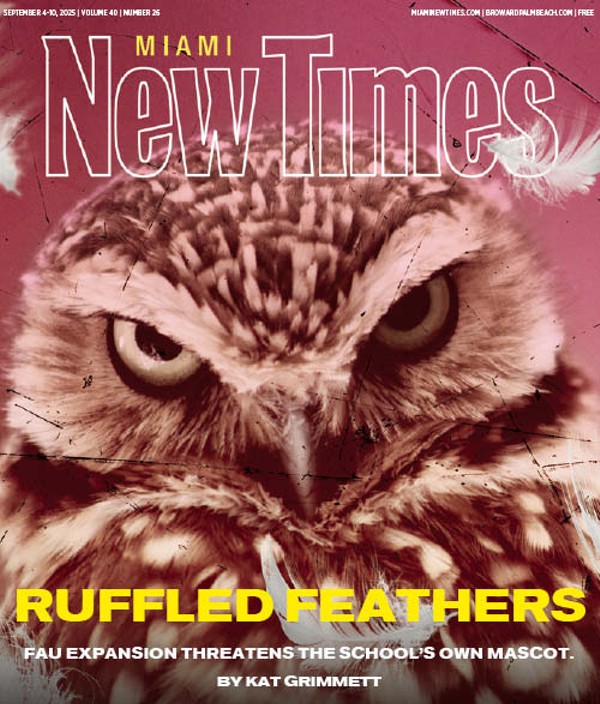The public first fell for her as the heroine of the sexy novel The Tale of the Chevalier Des Grieux and Manon Lescaut by Abbé Prévost. It was the saga of a fast girl's rise and fall that was turned into operas by Auber and Massenet. Then the young Italian got hold of it and transformed Manon Lescaut into his first hit. Though others loved her, Puccini loved her best: Only Madama Butterfly rivaled Manon for the composer's affection, and he even took great pleasure in distinguishing how he treated her story differently from his rivals' versions. "Massenet feels it as a Frenchman," he wrote to a friend while composing his opera, "with the powder and the minuets. I will feel it as an Italian, with desperate passion."
He did just that. Manon Lescaut premiered in Turin in 1893. Its fame soon spread, and Puccini became Verdi's undisputed successor.
But Florida Grand Opera's production now onstage at the Carnival Center's Ziff Ballet Opera House doesn't do it justice. FGO's inaugural season at the center so far has been sterling; its rousing Ada signaled the company's laudable ambitions. But no lucky streak lasts forever, and this Manon Lescaut, which opened Saturday night, is a vulgar, provincial, dull affair.
The opera deserves better. Puccini indeed succeeded in drenching the tale with the fervor of a love that is as common among the young as it is impossible. He also succeeded in making the most of the Wagnerian influence in the air, organizing his music subtly into a symphonic whole that can and should move the audience to tears. A young girl on her way to a convent is waylaid by true love and then distracted again by easy wealth, which becomes her downfall. The emotions are real, and they are all in the music.
With a decent conductor and a solid cast, this opera works — often beautifully. At the Ziff, however, trouble began the moment Maestro Angelo Cavallaro raised his baton. The orchestral prelude was hectic, choppy, and unfeeling — as well as tough for the strings to negotiate. When the curtain went up on "A Square in Amiens," it wasn't so much the tired set that alarmed, but the badly acted, silly business: Key entrances, as well as important exchanges, were lost throughout the evening as Bernard Uzan's stage direction focused on precisely the wrong thing nearly every time. Why have such a slavishly naturalistic set and then push performers to do unnatural stuff?
Opera fans are able to ignore all of that if the singing is exquisite. It wasn't. It was just loud. Loudest of all was Hugh Smith as Chevalier Des Grieux, Manon's impetuous young lover. This character gets most of the music, so he'd better be good. He's also supposed to be a hottie, someone worth ditching the convent for. Smith's stage presence recalled a young Meat Loaf, even if his singing was not as refined as the Texas rocker's. The flirtatious Act I "Tra Voi, Belle, Brune e Bionde" was awkward and stiff, musically and dramatically. The famous "Donna Non Vidi Mai," Des Grieux's outpouring of lust and wonder after seeing Manon for the first time, was a scream. No, really, he screamed the whole aria, dividing it into short disconnected shouts as if legato were poison. He then proceeded to shout the rest of the score. Smith's voice is a powerful instrument, but love duets — like shouting matches — are a parody of opera.
As Manon, Sylvie Valayre boasted a big voice. An attractive woman with a seductive, veiled timbre, she might have the makings of a distinctive Manon. But in this production, Valayre's dramatic instincts were errant at the opening. For example, during "In Quelle Trine Morbide," Manon's crucial aria at the crossroads between a life of luxury with her sugar daddy and a possible return to the man of her dreams, Valayre stood and simply sang out the piece, correctly, like a student in a school recital. Guy Simard's lighting, mannered and exasperating throughout the evening, was at its worst here: stage lights dimmed, bright spot on the soprano, just to make sure no one was even tempted to take this aria seriously as part of any drama. Still, Valayre's last scene, though bordering on camp, showed promise and almost saved the final act.
David Kempster was alone among the principals in not embarrassing himself; he at least looked and sounded right as Manon's brother. Katherine Calcamuggio, as the lead madrigal singer, was musically interesting in this small role; perhaps we should hear her in something bigger.
FGO's home is new, so it's worth pointing out that the Ziff Ballet Opera House — like the Knight Concert Hall across the street — is emerging as one of the nation's best acoustical environments for live music. The house sounds good. Carnival Center's downtown Miami location still qualifies as pioneering, but the neighborhood is already jumping — from the moderately priced Manhattan Café to the hip late-night Pawn Shop Lounge. Suddenly Miami has an arts district.
The sets in this opera, designed by Uzan with Michel Beaulac, were similarly eclectic but more conservative. Manon's boudoir was fine. The cartoonish port scene was more Gilbert and Sullivan's Penzance than Puccini's Le Havre, however, and the final swamp thing was just ugly. Come to think of it, sad to say, that's about right for this Manon Lescaut. It wasn't pretty.












